CMP Nucleo is a family of powerful development boards specifically designed for fast prototyping and learning in the wild world of embedded systems and IoT. Boards developed by STMicroelectronics are known for flexible designs and wide usability within various applications. Build your smart home project or maybe embark on robotics – CMP Nucleo makes it easy to explore the world of microcontrollers.
History of CMP Nucleo Boards
CMP Nucleo boards have grown steadily in popularity since their introduction. Designed to bridge the gap between hobbyists and professionals, they offer a middle ground between simpler platforms like Arduino and more complex systems like Raspberry Pi. The goal was to provide affordable, versatile tools that anyone could use for learning or serious development.
Key Features of CMP Nucleo Boards
CMP Nucleo boards come with some standout features:
- Plug-and-play design: Quickly connect sensors and peripherals.
- ARM Cortex processors: These boards leverage powerful ARM Cortex cores for performance.
- Broad compatibility: Connect with a variety of modules to extend functionality.
Types of CMP Nucleo Boards
There are three primary categories of CMP Nucleo boards, each tailored for different needs:
- Nucleo-32 boards: Compact and lightweight, perfect for space-constrained projects.
- Nucleo-64 boards: Mid-range boards with more pins and capabilities.
- Nucleo-144 boards: Full-featured boards ideal for larger, complex projects.
Use Cases of CMP Nucleo
CMP Nucleo boards excel in multiple areas:
- Prototyping IoT devices: Quickly test concepts for smart homes or industrial settings.
- Industrial automation projects: Use them for robotics and machine control.
- Learning and experimentation: Educational institutions often use them for hands-on learning.
Why Choose CMP Nucleo?
CMP Nucleo strikes a balance between accessibility and performance. Beginners appreciate the ease of setup, while advanced users benefit from robust capabilities. Plus, the affordable price tag makes them a great option for anyone looking to build without breaking the bank.
How to Get Started with CMP Nucleo
Setting up your CMP Nucleo board is simple:
- Download and install STM32CubeIDE.
- Connect the Nucleo board to your computer via USB.
- Write and upload your first program to make an LED blink!
Programming Languages Supported by CMP Nucleo
CMP Nucleo supports several programming languages:
- C/C++: The primary languages used for STM32 programming.
- Python: Great for advanced control systems.
- Arduino compatibility: Some Nucleo boards can work with Arduino libraries!
Interfacing CMP Nucleo with Sensors and Modules
CMP Nucleo is designed for easy interfacing. Popular modules include:
- Temperature and humidity sensors: Ideal for weather stations.
- Displays and communication modules: For control panels and IoT dashboards.
Challenges When Working with CMP Nucleo
Although CMP Nucleo is user-friendly, there are challenges:
- Learning curve: Beginners may need time to get familiar with the tools.
- Debugging: Complex projects can be tricky to troubleshoot.
- Library support: Not every module has ready-to-use libraries.
CMP Nucleo vs. Arduino and Raspberry Pi
How does CMP Nucleo compare?
- Arduino: Simpler to use but less powerful.
- Raspberry Pi: More powerful but overkill for simple tasks.
- CMP Nucleo: A sweet spot between the two.
Real-World Applications of CMP Nucleo Boards
Examples of CMP Nucleo in action include:
- Smart home automation: Control lights, appliances, and security systems.
- Robotics: Use in robotic arms and automated vehicles.
- Education: Great for classroom projects and research.
Best Practices When Using CMP Nucleo Boards
- Update firmware regularly for new features and fixes.
- Manage power efficiently to extend battery life.
- Document code to make future troubleshooting easier.
Community and Support for CMP Nucleo Users
CMP Nucleo users have access to a growing community. Check out:
- Online forums for troubleshooting.
- STM32 documentation for official resources.




